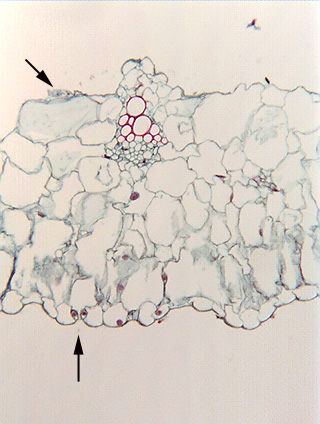Up
Ordinary epidermis
Guard cells
Thick cuticle
Thicker cuticle
Thin cuticle
Parasitic plant
Petal epidermis
Sclerified epidermis
Papillose epidermis
Sculptured cuticle
Elaborate cuticle
Cuticular horns
Radial walls
Cuticle proper
No epidermis
Epidermal peels
Cycad peel
Paradermal
Typical stoma
Sunken stoma
Stomatal orientation 1
Unusual orientation 2
Artifact
Stomata and fibers
Stomatal crypts
Crypts, mag.
Crypt margin
Non-crypt
Water lily
Stomatal channels
Groove, hi mag
Subsidiary cells
Ledges
Papillae
Trichome
Uniseriate hair
Peltate hair, mag
Peltate, lo mag
Branched hairs
Trichome base
Lithocyst, Ficus
Lithocysts, hemp
Bulliform cells
Grass epidermis
Multiple epi
Uniseriate?
Peperomia
| |
 Fig.
10.2-15. Transverse section of onion leaf (Allium cepa). This
leaf transverse section is different from most in this chapter: there is an
epidermis on the lower side of the micrograph (vertical arrow points to a
stoma), but there
is no upper epidermis (diagonal arrow points to cell debris). This is
from the green part of an onion leaf, not the white part. The green part of the
leaf is hollow because the leaf tissues have torn apart, and that is
what we are seeing on the top part of this micrograph. You can tell that the
upper layer here is not an epidermis because the cells have irregular sizes and
shapes. Although this layer lacks stomata, that is not an absolute criterion for
saying that this is not epidermis: many true epidermises lack stomata (many
petals and stamens, for example). Fig.
10.2-15. Transverse section of onion leaf (Allium cepa). This
leaf transverse section is different from most in this chapter: there is an
epidermis on the lower side of the micrograph (vertical arrow points to a
stoma), but there
is no upper epidermis (diagonal arrow points to cell debris). This is
from the green part of an onion leaf, not the white part. The green part of the
leaf is hollow because the leaf tissues have torn apart, and that is
what we are seeing on the top part of this micrograph. You can tell that the
upper layer here is not an epidermis because the cells have irregular sizes and
shapes. Although this layer lacks stomata, that is not an absolute criterion for
saying that this is not epidermis: many true epidermises lack stomata (many
petals and stamens, for example).
The white part of on onion – the part that we slice up to put on
hamburgers or to make into onion rings – that part is also a hollow leaf, but
it is hollow because it is tubular, not because it is torn apart. For details,
see Ontogeny of unifacial leaves (page 265) and fig. 12.41 (page 264) in Plant
Anatomy (Mauseth).
|
 Fig.
10.2-15. Transverse section of onion leaf (Allium cepa). This
leaf transverse section is different from most in this chapter: there is an
epidermis on the lower side of the micrograph (vertical arrow points to a
stoma), but there
is no upper epidermis (diagonal arrow points to cell debris). This is
from the green part of an onion leaf, not the white part. The green part of the
leaf is hollow because the leaf tissues have torn apart, and that is
what we are seeing on the top part of this micrograph. You can tell that the
upper layer here is not an epidermis because the cells have irregular sizes and
shapes. Although this layer lacks stomata, that is not an absolute criterion for
saying that this is not epidermis: many true epidermises lack stomata (many
petals and stamens, for example).
Fig.
10.2-15. Transverse section of onion leaf (Allium cepa). This
leaf transverse section is different from most in this chapter: there is an
epidermis on the lower side of the micrograph (vertical arrow points to a
stoma), but there
is no upper epidermis (diagonal arrow points to cell debris). This is
from the green part of an onion leaf, not the white part. The green part of the
leaf is hollow because the leaf tissues have torn apart, and that is
what we are seeing on the top part of this micrograph. You can tell that the
upper layer here is not an epidermis because the cells have irregular sizes and
shapes. Although this layer lacks stomata, that is not an absolute criterion for
saying that this is not epidermis: many true epidermises lack stomata (many
petals and stamens, for example).